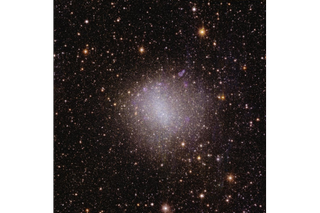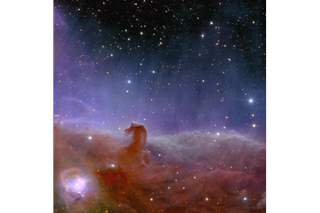Editor’s note: The new images from the Euclid telescope were released at 5:00 a.m. EDT (12:00 p.m. CEST). You can see the five new views of the cosmos here in our image publishing history.
The European Space Agency (ESA) will today (23 May) release five new images from the Euclid space telescope. Well, if the previous set of images is anything to go by, space fans should be in for an absolute treat.
“Five new portraits of our cosmos have been captured during the first phase of Euclid observations, each revealing astonishing new science,” ESA officials said in a statement. “Euclid’s ability to unlock the secrets of the cosmos is something you won’t want to miss.”
The new images will be revealed at 5:00 a.m. EDT (12:00 p.m. CEST) and will be accompanied by around ten incredible scientific articles. You can watch the data release live on the ESA YouTube channel.
Related: Euclid’s telescope from the ‘dark universe’ is defrosted a million miles away
As an appetizer for the occasion, perhaps we could recall the incredible cosmic images that this mission has delivered so far.
Euclid’s story so far
Launched July 1, 2023 from Cape Canaveral, Florida atop a SpaceX Falcon 9 rocket, Euclid is a wide-angle space telescope with a 600-megapixel camera that observes the cosmos in visible light, a near-infrared spectrometer and of a photometer which is used to determine the redshift of galaxies. Knowing redshift allows scientists to determine how fast distant galaxies are moving away from our planet.
Euclid’s main mission is to study the two most mysterious elements in the universe: dark energy and dark matter. These phenomena collectively constitute what is often referred to as the “dark universe.”
Dark energy is the reserved name given to any force that accelerates the expansion of the universe. Dark matter, on the other hand, is a form of matter that is effectively invisible because it does not interact with light. This means that scientists know that it is not “ordinary” matter made up of electrons, protons and neutrons that includes stars, planets, moons and our bodies. Dark matter can only make its presence known through its interactions with gravity, which can, in turn, influence ordinary matter and light. To be clear, however, neither dark matter nor dark energy are necessarily made up of a single thing. Both may be made up of many things – or perhaps they are indeed each made up of a single homogeneous thing.
The fact is, we just don’t know.
Nonetheless, dark energy is thought to make up about 68% of the universe’s energy and matter budget, while dark matter makes up about 27%. This means that the dark universe makes up 95% of the stuff in the universe, and the things we actually understand make up only about 5%.
So, nicknamed “detective of the dark universe” because of his specific set of instruments, Euclid clearly has his work cut out for him. But the space telescope’s first official images released on November 7, 2023, after its first four months in space, showed it was up to the task.

Just above is one of the first images the public saw from the Euclid telescope. This is a snapshot showing around 1,000 galaxies, all belonging to the Perseus cluster. Located approximately 240 million light years from Earth, this cluster is one of the largest structures in the known universe.
Mapping galaxies in such enormous volumes is essential for understanding how dark matter is distributed and how this distribution has influenced the evolution of the universe.
Beyond the wealth of galaxies in the Perseus Cluster, the image also shows 100,000 other galaxies much more distant, each containing up to hundreds of billions of stars. Observations of large numbers of distant galaxies like this are essential for Euclid to understand how dark energy pushes these galaxies away faster and faster by accelerating the expansion of the space between them.

Just because Euclid has his eyes set on vast swathes of galaxies doesn’t mean he can’t impress with unique galaxy images.
Ironically, another of the first images of Euclid that we saw was of an instrument responsible for revealing the dark elements of the universe. That’s because it identified the galaxy IC 342, also known as the “Hidden Galaxy.”
This galaxy is located about 11 million light years from Earth and is difficult to image because it lies behind the bright, dusty disk of the Milky Way. However, that didn’t stop Euclid from capturing an incredible image of this once-hidden spiral galaxy. To do this, the space telescope used its near-infrared instrument, which is advantageous because the gas and dust in the Milky Way’s disk are less effective at absorbing infrared light than other wavelengths of electromagnetic radiation.

To uncover the mysteries of the dark universe and create a detailed 3D map of the cosmos, Euclid will need to observe galaxies as far away as 10 billion light years away, seeing the 13.8 billion year old universe as it it was less than 4 billion years after the Big Bang.
These galaxies are unlikely to possess the neat spiral-shaped arrangements of the Milky Way or even the Hidden Galaxy. Most galaxies in the early universe are irregularly shaped “blobby” galaxies that served as the basis for larger galaxies.
To prepare for observing these distant and early galaxies, Euclid’s first images included a view of the more local irregular galaxy, NGC 6822, located just 1.6 million light-years from Earth.

Although they provide us with spectacularly scintillating images, Euclid won’t be focusing solely on galaxies during his mission.
As shown in the image of NGC 6397 above, the space telescope will also observe globular clusters. And luckily, globular clusters are just as beautiful. These are conglomerations of hundreds of thousands of stars linked together by gravity and are among the oldest structures in the known universe.
NGC 6397 is the second closest globular cluster to Earth, approximately 7,800 light years away. Globular clusters like NGC 6397 orbit the disk of the Milky Way and may hold clues to the evolution of our galaxy, or at least other galaxies in which such structures are found.
Euclid will excel at studying globular clusters because, unlike other telescopes, it has a field of view wide enough to capture entire globular clusters in a single image, just as it did for NGC 6397.

Much of Euclid’s mission will focus on the unknown, but the latest image from the first batch of Euclid releases actually showed us a familiar celestial object in a whole new light. The Dark Universe Detective was able to create an incredibly detailed panoramic view of the Horsehead Nebula, also known as Barnard 33.
Located approximately 1,380 light-years from Earth and near the eastern edge of Orion’s belt, the Horsehead Nebula is one of the most star-forming clouds of gas and dust closer to the solar system. It’s also quite a sight to see.
Although many telescopes have photographed the Horsehead Nebula in the past, none have captured this region of Orion’s molecular cloud with such a wide, clear view. What’s even more amazing about this image is that it only took Euclid an hour of observation to create it. It’s no wonder that professional and amateur astronomers as well as space enthusiasts are excited about the upcoming May 23 data release.
To that end, as stunning as the images detailed above are, chances are the best is yet to come from Euclid as he begins to achieve his mission objectives while shedding curious light on the dark universe.
We’ll have to wait until Thursday morning to see what the next crop of Euclid images has in store for us, and to see how this dark universe detective begins to meet the enormous expectations of his mission after almost a year in the space. But, again, if its past is any indication of its future, it’s hard to imagine anything other than the information-rich beauty of these images.